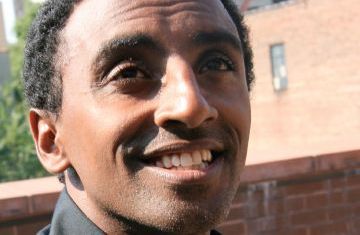
Above: Marcus Samuelsson at his home in Harlem, New York.
(Photo Credit: Tesfaye Tessema for Tadias Magazine).
Tadias Magazine
By Tseday Alehegn
New York (Tadias) – It’s a slightly drizzly evening in Manhattan and I’m walking with a loping gait to Aquavit restaurant, anxious that I am tardy, simultaneously juggling my umbrella, checking whether I brought my voice recorder, notes, interview questions and pen. My hurried steps are sharply interrupted by the calm and warm colored entrance of Marcus Samuelsson’s Scandinavian restaurant. As I wait by the door, slow down my pace, and go through the questions in my mind, I see his familiar figure, the midnight blue of the Aquavit uniform, a blackberry in hand and a welcoming smile. “Let me show you on a quick tour,” he says after we greet, knowing that it’s my first time here. “First – the kitchen.”
The spacious kitchen is divided by two main isles behind each of which stand a row of chefs, working like clockwork. Each plate out in front stands ready to be modeled as the most soigné art that food could be transformed into. We make an exit towards the café and settle down to talk about his most recent project – an adventure-filled trip throughout the African continent and the journey that led to his new book: The Soul of a New Cuisine. As I pull out my notepad and prepare my notes, Marcus steals a few moments to scroll through the emails on his blackberry. In just a few hours, after we wrap up our interview, he will be packing for another trip back to Ethiopia to see his birth father and his eight half-brothers and sisters, with whom he was first reunited in April of 2005. “I have to leave on a personal trip to Ethiopia, but I wanted to have this conversation now rather than later,” he says, then he turns off his phone, restores it in his pocket and lets me know that he is ready for our duologue.
Africa on My Mind
The first time that Tadias Magazine had interviewed Marcus was in March 2003. Marcus had mentioned back then that he intended to work on an African cookbook. He had concluded the interview by saying that he wanted to write not just about Swedish or American food, but also about African cuisine. “People lump all of Africa, as if it’s one homogenous country,” I recalled him saying, and I remember the eagerness and determination in his voice to make this project a reality. Fast forward three years later and Marcus has traveled extensively with his photographer and friend, Gideon Kifle. Together they go from South Africa to Morocco; from the famous spice island of Zanzibar to the fish markets of Senegal.
“I have gone several times, but I began my travels to Africa in ’99.” Marcus says. “For as long as I can remember, I’ve had Africa on my mind,” he writes in the introduction of his new book, and he pieces together culinary treasures with his intimate, personal journey to the village where he was born as Kassahun Tsegie. His journey to reconstruct his family heritage is as much a journey of peace as is his quest for peace embodied in the sharing of food across cultural terrains. “My favorite term is ubuntu,” he says – a popular South African concept which translates as “I am what I am because of who we all are.” Being a chef is about remembering and practicing ubuntu. It is about food for the body and soul that peacefully unites us as beings, allowing for conversations and the sharing of happiness, knowledge, soul and love.
“I’m a Swede, I’m also an Ethiopian, and a New Yorker,” he says.
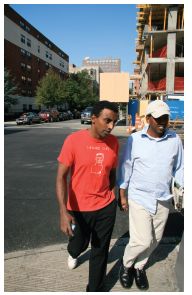
ABOVE: Marcus Samuelsson and
Liben Eabisa walking in Harlem,
New York.
He can’t help but embrace and reify diversity in his identity and in his work. Marcus’ personal story of his adoption by Swedish parents, his passion for cooking and his eventual move to New York as one of the top chefs in the world is as colorful as his fusion of recipes renowned for their flavor, originality, and multicultural emphasis. Weaving together the diverse fabrics that constitute his life’s journey, Marcus reflects on his youth growing up in Sweden. “The difference between an immigrant and an adopted kid, is that when you are an immigrant you are more clear on your identity; you are Ethiopian. When you are adopted you are stripped a little bit of one identity, and when you grow up you sort of go back to that identity.” “And again, I can only speak for me, I can’t speak for someone else,” he adds.
“For me coming to America, and New York in particular, and being around Ethiopians, going to all the concerts – to weddings, to restaurants, I found a whole lot of community.” He compares his upper middle class Swedish upbringing with that of his childhood friend Mesfin’s, who lived in close proximity to Stockholm’s ‘Little Ethiopia’ neighborhood. “What my friend Mesfin had was a community that I wasn’t familiar with. He was exposed to Ethiopian music, language, identity and customs,” Marcus recounts. “Once I was in New York however, by going to Meskerem and Sheba [restaurants] and making friends like Yeworkwoha [owner of Ghenet Restaurant] who introduced me to work behind Ethiopian food, I got immersed in Ethiopian culture.”
My Medium is Food
His eyes light up and he lifts his head and chest higher as he admits that his exposure to a broader Ethiopian and African community as well as the overall spirit of internationalism in New York got him ruminating over how to tie it all together. “And it was only then that I started thinking, What can I do? What’s my medium? Well… my medium is food. So I went back there [Ethiopia] and gave a couple classes at the Sheraton for Ethiopian kids. For me it’s not a one-off , I want to be in the country with Ethiopian children, and show young people, show young men how to cook.”
From there Marcus vowed to see as much of Africa as he could, and to capture the myriad of dishes and ways of sharing and eating food that he discovered in his travels. While Marcus worked with Gideon on article assignments about Ethiopia for American news outlets, he also started thinking of other ways of giving Ethiopians tools to be proud of.
“There are so many stories coming out of Sweden in comparison to my Ethiopian side,” Marcus points out. “Cars, IKEA, there are so many brands coming out of that little country, and in the case of Ethiopia although there are many rich stories, the music, the art, the food..you don’t get as much exposure to it. So I wanted to do a project that viewed Africa and its cultures,” he concludes. “You know a lot of people think of Africa as war, famine, all this stuff , and for me..it’s like..every part of the world has that.”
Marcus has other reasons for wanting to write about the cuisine of the African continent and its diaspora. “Africa also has a huge deposit of oral history. A mother tells her daughter about music and food and so on. And this tradition of oral history is important, but the written history is also important,” Marcus asserts. “You know just going to Barnes and Noble you can find 500 books on Tuscany, a tiny region, and for a huge region like Africa you have three books.” Marcus is determined to show where the influences in Africa came from and where African influence spread to. “So in East Africa and Ethiopia, for example, you can see the Indian influences in their food, and when you go down to southern Africa you recognize Indonesian and Malay food. No part of the globe is untouched by Africa and vice versa.
Soul of a New Cuisine
Motivated to show and encourage African-to-African connections, Marcus reflects on opportunities to learn from each other. “In general, South Africans don’t go up to Morocco and you don’t see Ethiopians going down to Angola. But it’s important to develop these connections, and it’s easy to do so through food. If I’m an Ethiopian family, let’s do a Senegalese dish tomorrow. Or if I’m Senegalese let me make a Malay dish tomorrow. Pan-European and Pan-Asian cuisine is a common occurrence now. You know if I am a Swedish family, Monday I have Italian, on Tuesday I’ll really like this French recipe and then on Wednesday I cook Swedish again. Well Ethiopians… we cook our food. And that’s great and it’s very nice,” he says. “But what if we just try a different path?”
“The food itself, the recipes may be ancient,” Marcus says of African cooking, “but I want this book to be a fusion of African cultures and food…sort of looking into the window of other countries within Africa. And ‘Africa’ doesn’t mean you have to live in Africa to experience it. It’s more about revealing this diversity, the richness, and being open-minded.” The combinations are endless and the experiences will be new, hence the title, The Soul of a New Cuisine. Along with the recipes Marcus has prepared a music album entitled Afrikaya, a compilation which features world music diva Gigi, and the new Ethiopian hip-hop fusion Bole to Harlem. “So it’s food, music, and people. I want something that other Africans will be proud of. The ‘new cuisine’ is that I make all these recipes palatable for Americans and the Western world.” Pan-African fusion is something you can’t find here on a regular basis.
“For example, I take an Ethiopian Shiro and I pair it with a fish dish from Morocco while borrowing cooking techniques from South Africa. So there is a fusion within the continent. And that’s what the ‘new’ is about.” As another example, Marcus suggests the term ‘Pan-Asian.’ “When I use this term with you, ‘Pan-Asian,’ you understand what that is. You can envision the fusion involved, which today is also considered fine dining.” “Fine dining,” Marcus reminds me, “came from a very elitist society.” It conjures up the image of French restaurants, a certain culture only for the upper class. “Today the fl avor of the food is considered fine dining. Now you go to Paris or London and they are catching on to fusion. So in the same way, you understand the term Pan-African as it relates to music, but how about Pan-African food?” Marcus gets us thinking about Pan-African ways of making and eating food.
The communal aspect of African cooking and ways of eating are very much a central core in Marcus’ writings. “In Senegal I stayed with my dishwasher’s family,” he shares. “They had grandmothers and other family members all living together. That was a way for me to get close.” It may have been more comfortable to travel throughout Senegal as a tourist, staying in hotel rooms and visiting local eateries, but Marcus knew from the start he would miss the fervor of communal cooking if he chose such a path. “You know I can’t wing it. I can’t do it from hotels either. I wanted to be there form the start, when they made breakfast and when they made lunch..to see the cooking together. I have to see it to really know it.” He took this attitude with him wherever he traveled to, and he noticed that although the recipes may be starkly different, the eating patterns throughout Africa had one thing in common – they were very communal. “Kids are welcome and grandparents are welcome in the preparation of food,” he notes. “In Africa, how we start a meal and how we feed each other…it’s very communal and it brings extended families together.”
From farming, to harvesting, to cooking, and to selling food in the marketplace, food transactions are a communal business. “I’ll tell you about the fish market in Senegal, which has such a beautiful, organic way of working,” Marcus enthuses. “The men go out to fish, drop off their catch to the women who run the fish market.” He describes in colorful detail the women selling fish. “They have several skirts on..and they lift up one skirt and they have Euros, and then Dollars, CFA Franc [Senegalese money]..and it’s like NASDAQ.” He makes the whirring sound of money being counted and continues, “And the kids help package the fish while the people come to buy it, and there is a certain rhythm to it. That to me is colorful and loud.” And it’s the larger experience of food and food making that you don’t see when you purchase packaged meals at a supermarket.
Every Place is Great for Me
Between the moments of discovering new foods, tastes, and cooking techniques Marcus perambulates around the open markets. He mentions Marakesh and Merkato, the latter, considered one of Africa’s largest open-air markets, being his favorite. “I enjoy places like Merkato. Wherever people see danger, I enjoy it. I travel deeper and deeper and see the mix of Jewish, Muslim, and Orthodox traditions. I just love it,” Marcus says. “What makes travel interesting is the people, their history, where they came from and where they are going to.” He points out that food, like any other aspect of culture, has its own history, and learning about food without the history wouldn’t make for a full experience. “Because of their history of trading with Arabians and Indians, the food of the people of Zanzibar is so flavorful,” he says. And he implants pieces of history among his recipes so that it becomes an exploration of a continent’s way of food and not just the raw ingredients. “I want to bring you onto that journey. And I have to do it thoroughly,” he says. “I have been privileged to go and be in South Africa, Sweden, New York, to Ethiopia. Most people haven’t had that opportunity.”
I ask him which place he enjoyed the most, but Marcus is quick to answer “Every place is great for me.” “In order to do this [work] you have to be really curious,” he adds. “And there are stories everywhere..people are eager to tell you.” Marcus enjoys traveling. “Bahia is different from the rest of Brasil, and Addis Ababa has a different story than Soweto. You know when I’m in Ethiopia. It’s great. I feel at home. But when I go to a new place like Soweto, a place I’ve never been, and then Desmond Tutu writes the forward to my book, it takes on a whole other meaning for me. So I enjoy all of it…the entire experience.”
The Universal Peace of Food
The end result is a new cookbook, lots of travel stories, adventures, and something for UNICEF’s programs for children around the world. Marcus is donating part of the proceeds of The Soul of the New Cuisine to UNICEF programs. “There are so many great organizations in the world, but I picked two to work with: UNICEF and CCAP – one works with children internationally and the other works with public high school students.” As a goodwill ambassador for UNICEF, Marcus had to come up with a program and he chose this cookbook as one of them. “I have been down to Ethiopia and seen the NGOs working. I don’t want to micromanage the process, but if I believe in your work then I’ll let you do your work the way you believe is best.” It’s all part of the process of using food as a medium of peace.
When you think of the first presence of food in your life, it’s easy to picture the image of a mother giving life-sustaining milk to her newborn child. One of the first acts of bonding and love is expressed through food. Mozart once said, “Neither a lofty degree of intelligence nor imagination nor both together go to the making of genius. Love, love, love, that is the soul of genius.” This is apparent in Marcus’ work.
“One thing that’s really cool about food is that everyone thinks their recipe is the best. But it’s great that they don’t fight about it. It’s not like money, and it’s not religion where someone is trying to convert you. Do you know what I mean? It’s peace,” Marcus asseverates with a smile and an earnest look in his eyes. As beings we are on a universal search for comfort and peace and Marcus shares how food is fundamental in that quest. “It’s a very peaceful way of taking pride in something. With food, people take a tremendous amount of dignity and say “I want to show you what I can do” without fighting,” he says “And I love that.”
The Soul of a New Cuisine is the new food, the new fine dining, and food itself is the universal peace.
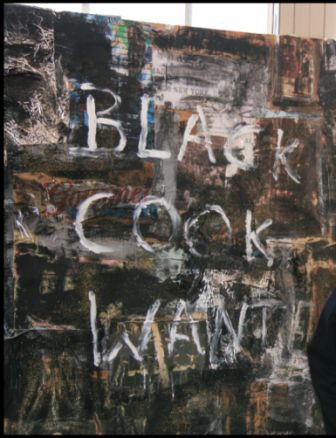
Above: Black Cook Wanted, painting by Samuelsson
Photos by Tesfaye Tessema for Tadias Magazine.
—-
About the Author:
Tseday Alehegn is the Editor-in-Chief of Tadias Magazine. Tseday is a graduate of Stanford University (both B.A. & M.A.). In addition to her responsibilities at Tadias, she is also a Doctoral student at Columbia University.





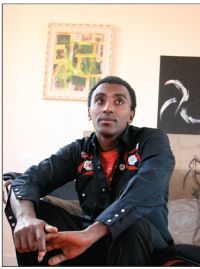
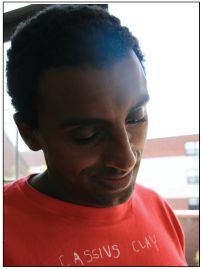
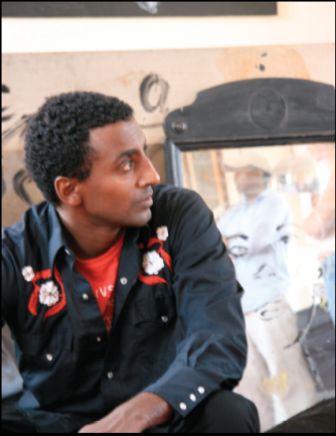
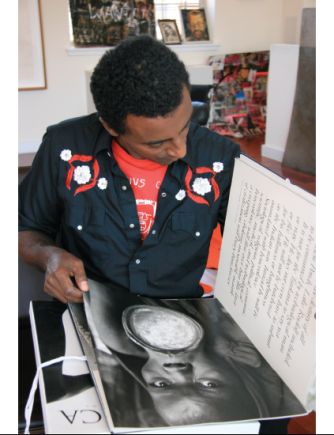





















I am so happy for MArcus Samuelsson. He is a really wonderful person.
It makes me know want to go out of my home to Barnes and nobels to get his book. I want to see the book I’m excited. MArcus you are great. I love you.
Love
Fikir
It is great to see the creativity and innovation that Marcus is bringing to African cuisine. Great job Marcus!
gosh, what an exceptional young man, i have been hearing about him for a few years now, AND he sure is handsome. i can’t be the only one who noticed this.